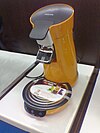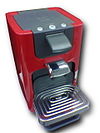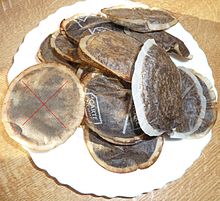Senseo
Senseo is the brand name of the first portion coffee machine with coffee pods , which was developed in 2001 in a cooperation between the electronics manufacturer Philips and the Dutch coffee roaster Jacobs Douwe Egberts .
The name Senseo stands on the one hand for the machine from the manufacturer Philips, with which the coffee of the coffee roaster Douwe Egberts is prepared, and on the other hand for the portioning shape of the coffee in special pods , which initially only from Douwe Egberts and now from many other manufacturers Tobe offered. Senseo was launched in Germany in 2002. Over 33 million devices have now been sold worldwide.
concept
The pre-portioned coffee is placed in the device using so-called coffee pods. With 7 g of coffee powder, one pad contains roughly the amount that is generally recommended for a cup of coffee (also for conventional filter coffee; 1 coffee peel or 6–8 g per 125 ml cup). With a pressure of about 1.4 bar , the water heated to over 90 ° C is pressed through the pad within about 40 seconds. Due to the short contact time of the water with the coffee powder, the device achieves a composition for the filter coffee produced that, as with all pressure systems, is relatively low in irritants and bitter substances, as these remain in the pad.
The Senseo coffee pad machine has a by patents protected brewing system and a special foam chamber, with a similar Crema is created on the coffee, as they are of espresso and Schümli knows -Kaffee. However, this crema is just plain frothed coffee. The Senseo coffee pods developed for the Senseo coffee machine are matched to the brewing system in terms of their shape, mix, degree of grinding and roasting of the coffee beans and have been offered by more and more manufacturers - including discounters - since the system was launched.
Coffee can be made after a warm-up time of approx. 60 seconds (after switching on) and inserting a coffee pod. One or two coffee cups can be brewed at the same time; therefore two different pod holders are included. The device has an automatic switch-off which is activated after a few minutes of non-use. All removable parts of this coffee machine are dishwasher safe.
Working principle

In contrast to the filter coffee machine, which continuously boils the water and transports it up into the filter through its own buoyancy (boiling bubbles), the Senseo brand machine first heats a portion of water completely in a built-in boiler and then pumps it through the pad with a vibrating armature pump . During the brewing process, the water does not continue to boil, but at a brewing temperature of approx. 90 ° C prevents the roasted aromas of the coffee from evaporating.
To ensure that the boiler in the machine is always filled with water, there is a float in the removable water tank, which allows the minimum fill level to be measured. If the fill level falls below the minimum, the heater is switched off by the electronics in the base of the machine and the switch-on LED flashes quickly. This ensures that the boiler's tubular heating element does not overheat. When using the machine for the first time or when it has been emptied, a special filling procedure must therefore be carried out to fill the boiler. Preventing air contact with the tubular heater also reduces limescale deposits. If the water level is sufficient, the next portion of water is heated up immediately after the brewing and filling process has been completed, which is indicated by the on-LED flashing slowly.
A three-way valve between the tank and brewing chamber prevents hot water from splashing out of a possibly open brewing chamber lid when the water is boiling in the boiler - instead, short water pressure surges are directed through an overflow that opens back into the water tank. The three-way valve is subject to a certain age, which is why older machines tend to pump more and more water not into the brewing chamber, but directly back into the water tank. Regular descaling counteracts this aging process.
development
Machine and accessories
When it was launched on the market (first in 2001 in the Netherlands), it was another form of coffee pod system, which, however, in contrast to the existing systems, quickly found numerous imitators. By May 2007, Senseo had sold over 15 million coffee pod machines and billions of coffee pods worldwide. In Germany, where the system came onto the market at the end of 2002, over five million coffee pod machines and several billion pods have already been sold.
Philips and Douwe Egberts tried to take legal action against numerous competing manufacturers, citing European patent EP0904717B1, which relates to a unit consisting of a container and a coffee pad. This patent was revoked on August 30, 2006 by a Board of Appeal of the European Patent Office, so that other coffee roasters can now also manufacture and market coffee pods for Senseo coffee pod machines.
After a short time, Philips introduced a successor model to the coffee machine, which, however, differs little in appearance from the previous model. What was new was an improved locking mechanism, an improved cup shelf (now also suitable for a cup height of 9.5 cm) and the reduction in power consumption from around 1700 to 1450 watts with the same brewing time through the use of a boiler that is only partly made of stainless steel.
A larger water container with a capacity of 1.5 liters is available as an accessory in stores, which is a great advantage when it is used more often (for example in the office).
At the beginning of September 2006, Philips presented another generation of Senseo coffee pod machines under the name "New Generation". The design has been revised and the standard water tank now offers a capacity of 1.2 liters. The newer coffee pad machines are available in three versions, the most expensive version having an LC display with an input button with which you can set the amount of water in three stages, as well as a height-adjustable coffee outlet. The top version is far more expensive than the original devices (recommended retail price of the manufacturer € 129), but they will still be in the range.
At the end of 2008 Philips launched the “Senseo Latte Select” coffee pad machine. This has an integrated, removable milk container and an additional pump plus steam generator with a power consumption of 1200 W. This makes it possible to froth milk and make coffee specialties such as latte macchiato, cappuccino and café latte. Nothing has changed on the pads, they are still compatible with older devices.
The Senseo "Quadrante" has been on the market since September 2009. In addition to the eye-catching, now square shape, Philips has focused on making this machine more convenient to use. The height of the cup tray is adjustable to avoid splashes; the water tank has a recessed grip for easier removal, and the height of the water tank now fits under all common faucet systems. Due to the changed design, the pod holders from the typical curved machines are not compatible with the Quadrante. The three control buttons are located in the lid, the locking position of which is queried by a Hall sensor .
The design of the “Twist” generation introduced at the end of 2012 has undergone major changes: the water tank, which was always integrated into the machine in the previous models, is positioned slightly to the right and is therefore more visible. The control buttons previously located on the front or on the cover have given way to touch buttons with numerous display LEDs next to the machine. The cup shelf, including the drip tray, can now be completely separated from the machine. As an option there is a Brita water filter for the tank as well as models with an attached milk frother ("Twist & Milk").
In 2013, the Senseo “Latte Duo” was introduced, a machine that can use coffee pods to prepare two coffees with freshly frothed milk at the same time. The milk is sucked in from any container through a hose.
With the Senseo "Up", a particularly narrow model will be presented in 2014, the width of which is just over 10 centimeters. The reduction in width was achieved by a greater depth of about 35 centimeters. The Senseo "Up" can only make one cup of coffee at a time. The coffee is prepared by pressing a button once; a separate switch-on is no longer necessary with this machine. With the "Up +" version, the desired filling quantity can also be set individually.
Machine overview
Compilation of machine types and generations from Philips:
| Philips series designation |
basic | original | New Generation / Viva Cafe |
Latte Select | Quadrant | twist | Latte duo | Up |
|---|---|---|---|---|---|---|---|---|
| generation | 1 | 2 | new | - | - | - | ||
| Models | HD7800-HD7801 | HD7805-HD7816 | HD7820-HD7842 | HD7850-HD7854 | HD7860-HD7864 | HD7870-HD7874 | HD7855-HD7857 | HD7880-HD7884 |
| Launch | 2001 | 2002 | 2006 | 2008 | 2009 | 2012 | 2013 | 2014 |
| Power [W] | 1650 | 1450 | 1450 | 1450 (+1200) | 1450 | 1450 | 2650 | 1450 |
| Standby consumption [W] | 0.25 | <1 | <1 | 0.22 | ||||
| Tank volume [l] (alternative tank) | 0.7 (1.5) | 1.2 | 1.2 (milk 0.12) | 1.2 (no) | 1 | 0.7 | ||
| Tank withdrawal | back | back | back | rear (milk front) | laterally | laterally back | back | back |
| service | Keys | Keys | Keys | Keys | Keys | Touch | Touch | |
| Show | LED | LED | LED (option: LCD) | LED | LED | LED | LED | |
| adjustable spout | No | No | Yes | No | No | Yes | ||
| alternative pad holders | No | espresso | espresso | espresso | espresso | espresso | ||
| Water filter possible | No | No | No | No | No | Yes | ||
| Dimensions W × H × D [mm] | 215 × 320 × 305 | 210 × 380 × 310 | 190 × 340 × 300 | 205 × 350 × 350 | 180 × 285 × 250 | 250 × 320 × 310 | ||
| Milk preparation possible in the model range | No | No | No | Yes | No | Yes | Yes | No |
| Volume adjustment | No | No | depending on model | Yes | No | Yes | Yes | Yes |
| Descaling indicator | No | No | Yes | Yes | No | Yes | Yes | Yes |
| Brewing chamber closure | 2 levers | 1 lever | 1 lever | 1 lever | 1 lever | 1 lever |
Pads
At first you could only choose between four types of coffee (mild, normal, strong and decaffeinated). Since 2005 there Cappuccino pads, since 2006 Espresso pads, since 2007 tea chocolate milk (pads, since 2008 in the Netherlands capsules with whom one hot Chocomel ) can be prepared in the machine and since 2010 organic coffee.
In the meantime, there is a large selection of pads for the Senseo machine or corresponding competing devices on the market - sometimes also at food discounters.
A special pad variant are the empty pads, which you can fill yourself with commercially available coffee powder or tea; these are available as disposable and reusable pads.
The “Espresso” pad version has also been available since the end of November 2006. With these pods and a special espresso pod holder belonging to them, espresso can be prepared with all Senseo coffee machines (exception: HD 7800, Senseo machine of the first generation). The espresso pod holder developed for this creates a higher pressure in the machine and ensures a lower amount of water, which with approx. 80 ml corresponds to about double espresso.
Modifications and extensions
Due to the simple technology and the widespread use, there are now a large number of private conversions and expansions, ranging from a changed design to the retrofitting of functions to a completely new development of the control.
criticism
One point of criticism with the machines of the first generation was the lack of switch-on protection: the brewing process could be started even when the device was open. This could lead to scalding. At the urging of Stiftung Warentest , among others , the devices were modified by the manufacturer so that customers are better protected.
The Stiftung Warentest also criticized the release of nickel in the scalding water, which can be problematic for people who are allergic to nickel.
There was also the accusation of lock-in when it was introduced . H. Introduction of a relatively inexpensive device that entails high costs due to the use of consumables (pads) that can only be obtained from the developer. A cup of coffee made with original Senseo coffee pods currently costs between 8 and 16 cents. The average cost of a normal cup of filter coffee is around 4–7 cents (depending on the price of the coffee).
Today, however, there are many Senseo-compatible coffee pods from competing manufacturers available that cost far less, because sometimes a cup of coffee is already available for less than 6 cents.
For criticism of the pad systems in general, see also the coffee pad system . The filter material used for the Senseo-Pads is compostable and therefore - apart from the outer packaging - suitable for the organic waste bin.
In 2009, the coffee pad machine was recalled in a major recall campaign because the boiler could burst under certain circumstances.
literature
- Test portion coffee machines Stiftung Warentest, issue 12/2009
Web links
- www.senseo.de
- Philips backgrounder Senseo® reaches 10 million happy users Detailed press release from Philips (2005)
Individual evidence
- ^ Sarah Lee Corp .: Sara Lee Corp. Signs Exclusive Partnership With Philips for all Philips-Branded Consumer Coffee Systems and Acquires Full Rights to Global SENSEO ™ Trademark. Cision PR Newswire, January 26, 2012, accessed March 13, 2019 .
- ↑ 1.4 bar is the nominal pressure according to DE202005020791U1
- ↑ Philips: Operating instructions for the model HD7810 , p. 7 "First use - rinsing the device for filling the boiler" (PDF, accessed on July 22, 2015)
- ↑ Decision T 0452/05 - 3.2.04, accessed on February 25, 2011 from www.epo.org
- ↑ a b The story of Senseo on philips.de (accessed on March 29, 2016)
- ↑ Philips Senseo Up HD7880 / 10 on testreports.de (accessed on March 29, 2016)
- ↑ Article on reusable coffee pods , accessed October 28, 2010.
- ↑ Website and list of modifications at the end of the Senseo Autostart page
- ^ Stiftung Warentest: Philips: Risk of scalding eliminated , test.de, January 23, 2003
- ↑ Stiftung Warentest: Coffee machines for capsules and pads in the test In: test 12/2006
- ^ Senseo: Recall due to bursting pressure vessel
- ↑ Recall Philips Senseo: One year later












